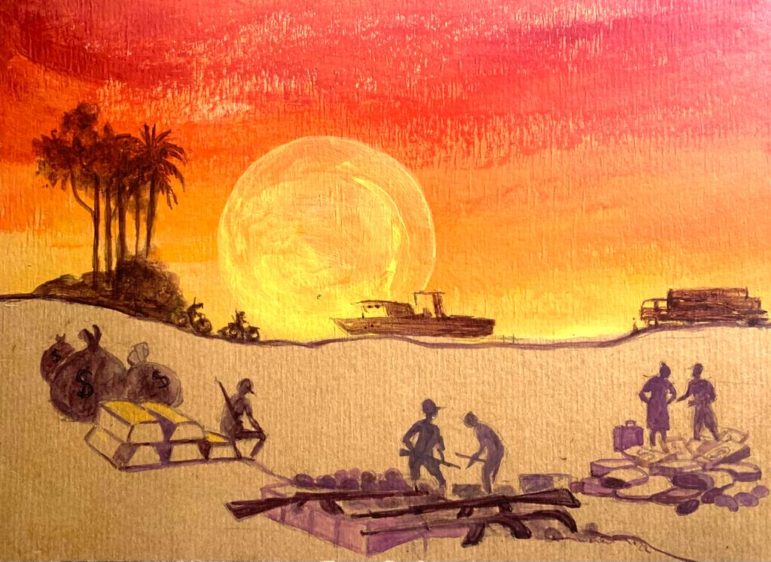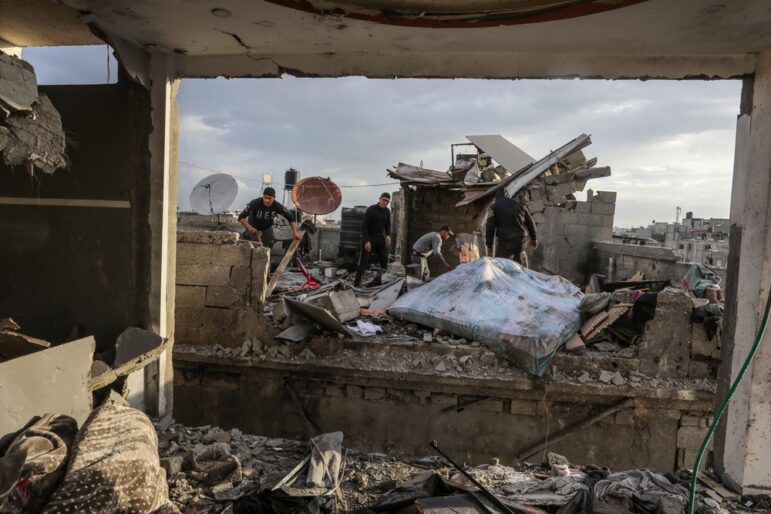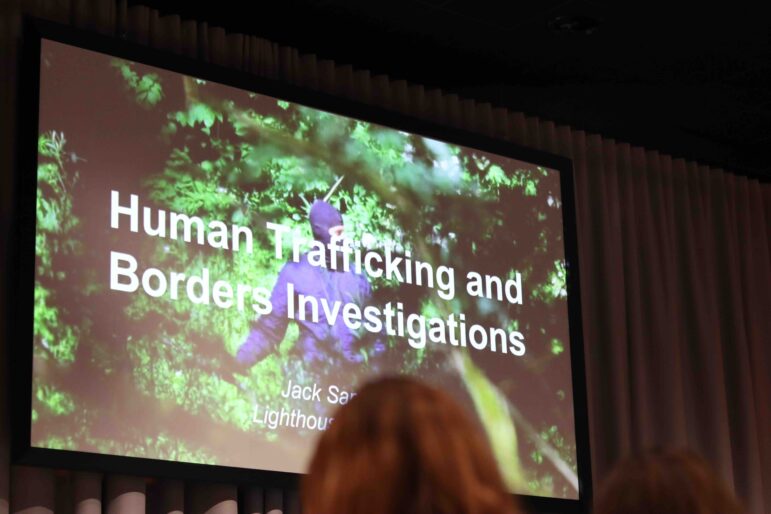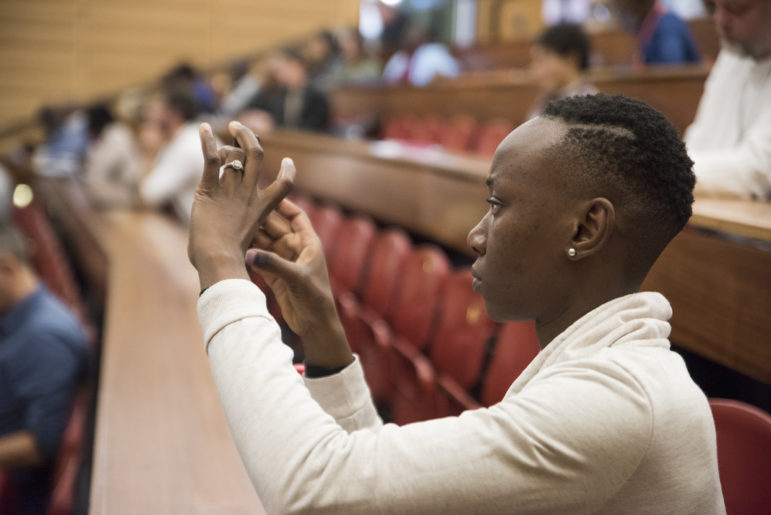

Slavery is thought by many to have been banished in an earlier age, but millions of people remain in forced labor around the world. Speakers: Martha Mendoza, Tim Sandler, Malia Politzer, Emmanuel Mayah. Madelene Cronjé
Reporting on Slavery: Tips from the Pros
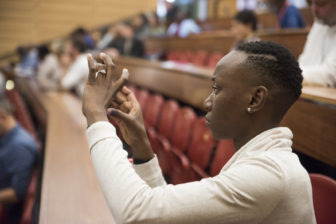
Reporters attend a panel on human trafficking and forced labor at #GIJC17 in Johannesburg. Photo: Madelene Cronjé
A staggering 40 million people in the world exist in some form of slavery today, according to estimates. This inherently secretive industry has attracted the attention of some of journalism’s finest minds. Four such reporters formed a panel to share their tips and experiences at “Exposing Human Trafficking and Forced Labor” at the 10th Global Investigative Journalism Conference in Johannesburg.
Transparentem investigations director Tim Sandler, AP reporter Martha Mendoza, longform freelance reporter Malia Politzer and International Center for Development Reporting editor Emmanuel Mayah shared some of their tips for connecting with sources and operating in the field.
Due to the nature of trafficking, it is difficult to find victims who are secure, in a sufficiently healthy mental state, and willing to talk.
Research
Talk to local NGOs. If possible, reach out to organizations that are survivor-led, said Sanders. In Mendoza’s Pulitzer Prize winning story “Seafood from Slaves,” which traced slave-produced seafood from Asia to major US supermarkets, they “crowdsourced.”
“We went to every relief organization and social service and labor organization and asked them ‘where did your people come from? Where did they describe being?’” said Mendoza. It was “definitely NGOs” that helped the team identify an island in Southeast Asia where more than 2,000 slaves who were being held.
Scour advertisements in local newspapers. “When you see advertisements in local papers recruiting workers abroad, they can give you an idea of who the middle men are, and how it goes and how much they’re promising for pay,” said Sandler.
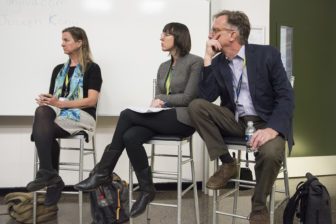
Journalists Martha Mendoza, Malia Politzer, and Tim Sandler share tips on reporting on forced labor and human trafficking. Photo: Madelene Cronjé
In his experience, victims often borrow from family members and friends to raise “extraordinary amounts of money” to secure the advertised job in their desired destination. Once they arrive, they find that it is not the job that was advertised, and the victims become economic prisoners – unable to repay the debts they incurred to get there.
Use technology. Satellite pictures, drone footage, and geo-finders such as Banjo can help you corroborate suspicious and win buy-in from editors, who can then send you to investigate the situation. Mendoza approached a company called DigitalGlobe, which takes satellite images of “every part of earth” every day. The company agreed to provide her with the images she requested, which led to further investigation into ships carrying fish. Since the success of “Seafood from Slaves,” DigitalGlobe has begun offering free satellite images to journalists by request.
When searching for victims of child labor, Sandler has some tips:
Track the harvesting seasons (“If you look for the cotton seasons or tobacco seasons invariably you’ll find children there if you know where to look,” he said); ask concerned teachers in suspected areas (teachers might notice long absences from school or signs of fatigue or abuse); and talk to local doctors or nurses who might be treating children exposed to harsh working conditions.
In the Field
Weigh the necessity of hidden cameras. When assessing the need to use a hidden camera, Sandler recommends weighing up whether what you’re hoping to record is in the vital interest of the public, whether you have exhausted all other alternatives, and whether you are willing to disclose any deception you used to your audience.
One way to handle this is to “disclose to the public and let them decide for themselves if it’s ethical or not,” he said.
Also, consider legal questions such as the risk of being prosecuted for trespass, invasion of privacy or defamation.
Lastly – and importantly– map out a strategy to follow if you get caught.
Work in teams. For “The 21st Century Gold Rush,” Politzer spent nearly two months in the field speaking to smugglers, drug dealers, child workers in Africa and Europe to examine who is profiting from the refugee crisis. In the process, Politzer came to appreciate the power of collaboration. She and her multimedia colleague played off each other to achieve things they couldn’t achieve alone.
“I was better with the children. She was better with the smugglers,” said Politzer. In one incident where a hidden camera was used in a sweatshop, Politzer interviewed the owner in one part of the building while her colleague shot footage in another.
And all the panelists agreed on the necessity of working with someone who can speak the language of the victims you are writing about. “They need someone to connect with,” said Mendoza.
Don’t overlook traditionally “trusted” figures as perpetrators. In an investigation in which Mayah exposed the trafficking of Liberian refugees, “it began from a most unlikely source,” he said. By following up on rumors in the area, he discovered that a UNHCR official overseeing a refugee camp in Nigeria was essentially trafficking refugees out of the camp. “She was a manager at the UNHCR, she was a woman, she was a mother,” he said.
Be sensitive to victim trauma. Be aware of signs of trauma in victims, such as memory loss, lack of focus, lack of overt emotion and multiple versions of a story, said Sandler.
Before talking to a victim, the panelists stressed the importance of ensuring that he or she is in the right state of mind for an interview. “You don’t want to re-traumatize the victim,” said Politzer. If possible, have a professional psychologist or counsellor “clear” the person for readiness before interviewing.
 Thalia Holmes is a South African freelance journalist specializing in business, health and long-form feature writing. She has won various national awards for her work. Previously she worked at the Mail & Guardian as a business reporter, and was a management consultant in a former life before finding her passion in media.
Thalia Holmes is a South African freelance journalist specializing in business, health and long-form feature writing. She has won various national awards for her work. Previously she worked at the Mail & Guardian as a business reporter, and was a management consultant in a former life before finding her passion in media.
 Madelene Cronjé is an independent photographer based in Johannesburg, South Africa. Formerly a staff photographer at the Mail & Guardian, she specializes in photojournalism and editorial portraiture.
Madelene Cronjé is an independent photographer based in Johannesburg, South Africa. Formerly a staff photographer at the Mail & Guardian, she specializes in photojournalism and editorial portraiture.

